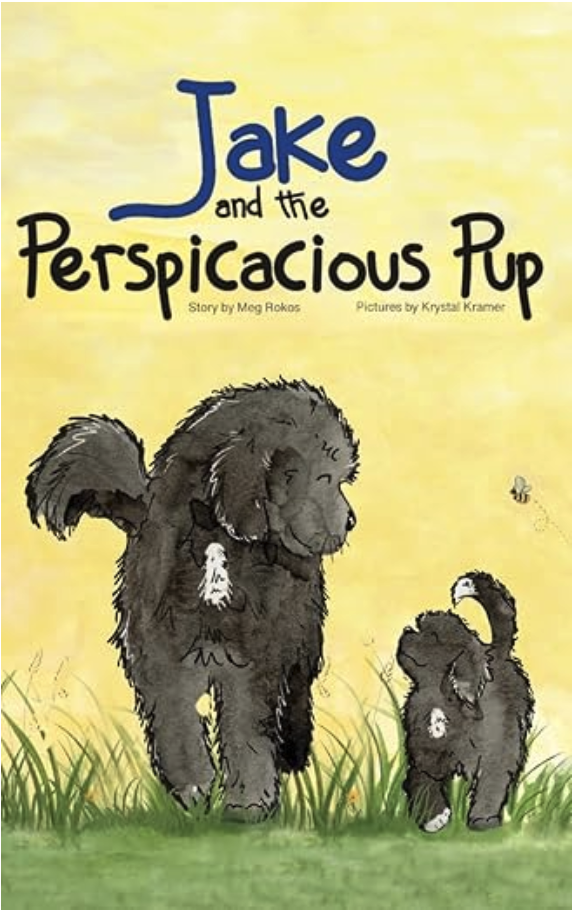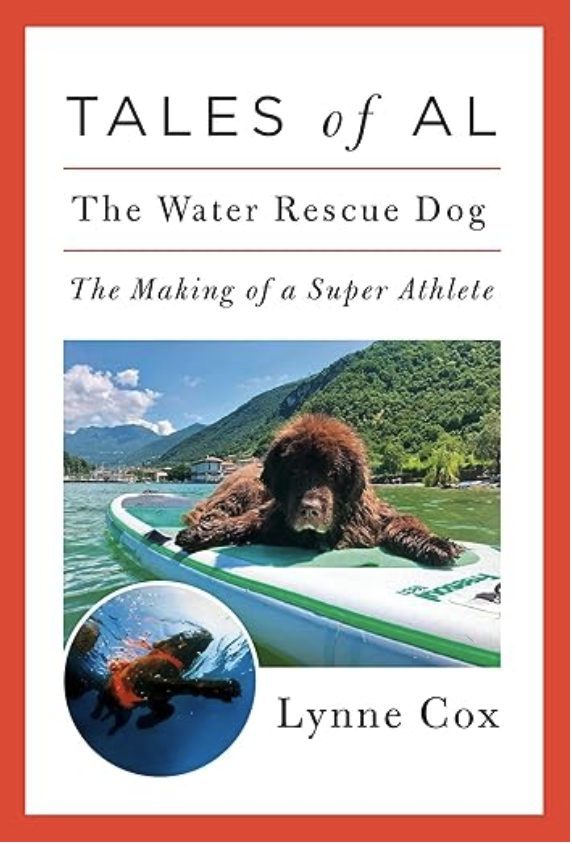From stormy coastlines to cozy firesides, the Newfoundland dog has long captured the imagination of storytellers young and old. In this collection of interviews, authors of both children’s and adult fiction reflect on the inspiration, symbolism, and sheer presence of this gentle giant in their stories. Whether as brave rescuers, loyal companions, or shaggy metaphors for strength and kindness, Newfoundlands have padded their way through the pages of literature with unforgettable charm. These conversations explore the creative process, the bond between humans and animals, and why the noble Newf continues to leave pawprints on the literary world.
 When happy-go-lucky Yogi meets a little baby, a beautiful friendship starts that transcends species for a one-of-a-kind child-dog relationship.
When happy-go-lucky Yogi meets a little baby, a beautiful friendship starts that transcends species for a one-of-a-kind child-dog relationship.
Inspired by a true story, Yogi's Kisses is a heartfelt children's book that encapsulates the beautiful relationship and sweet, loving bond of a little girl and her grandparents' dog. Author Beth McKee explains that the book encapsulates Yogi's real life bond with her granddaughter.
Yogi meets Leia as a newborn and falls in love with the little girl as she continues to grow. Yogi and Leia begin to have many adventures, all of which demonstrate the unique relationship and life lessons the special love a child and dog share with each other. Most of the adventures between Leia and Yogi take place at a small beach town, Half Moon Bay, California.
Throughout the illustrations and narrative of Yogi's Kisses, readers will experience how loving and caring for a dog teaches children the valuable life lessons of nurturing others and handling responsibility. Beth tells us that the book is truly a family affair, with the charming illustrations created by her daughter, Stephanie.
Palmetto Publishing is responsible for bringing Yogi's story to the wider world, and they said "We are honored to help BB preserve Yogi's legacy and bring his spirit to readers everywhere. Yogi's Kisses is a beautiful reminder of the unconditional love our pets give — and the lasting impact they leave behind." BUY THE BOOK
 When Kate brings home a new puppy, Jake's life is turned upside down. Not only does his lazy, peaceful routine end, but the puppy now gets all the attention from the humans! He is very unhappy with the changes that have happened. But then Jake remembers what it was like to be a puppy himself. Soon, he joins in the fun and explores Pippa's new world.
When Kate brings home a new puppy, Jake's life is turned upside down. Not only does his lazy, peaceful routine end, but the puppy now gets all the attention from the humans! He is very unhappy with the changes that have happened. But then Jake remembers what it was like to be a puppy himself. Soon, he joins in the fun and explores Pippa's new world.
We sat down with author Meg Rokos to talk about her new title. She and her family have had Newfoundlands for many years, she said the family "Loves their gentle nature and intelligence, and their love of water!"
Asked about what inspired the story, Meg relates: "As a puppy, Pippa was my muse. I could watch her discover the world for hours! One afternoon, my husband was throwing a ball for her, and in one of her better retrievals, she dropped it in front of Jake—who heretofore had cared less about balls. But Jake picked it up and gently put it in my husbands hands. My husband threw it again and Jake loped across the yard and fetched it. We were amazed, old Jake was suddenly a puppy for a brief few minutes! That was the germination of the story.
Noting the unique title, Meg noted that she wanted the title to be silly to say and a challenge for adults when reading aloud, and she hopes everyone will have a giggle and maybe add a new word to their vocabulary. BUY THE BOOK
 Lynne Cox is not a lifelong Newfoundland Dog fancier. She grew up with a Dalmatian and now has a Golden Retriever swimming buddy named Lois Lane. Lynne has focused her life on her passion of long-distance swimming, sharing her experiences in several well-received books. Then one day she came across video on her computer of the Newfoundlands working at the Italian School of Water Rescue (SICS), and just like that, she was hooked.
Lynne Cox is not a lifelong Newfoundland Dog fancier. She grew up with a Dalmatian and now has a Golden Retriever swimming buddy named Lois Lane. Lynne has focused her life on her passion of long-distance swimming, sharing her experiences in several well-received books. Then one day she came across video on her computer of the Newfoundlands working at the Italian School of Water Rescue (SICS), and just like that, she was hooked.
Like many of us, she was instantly fascinated by the sight of the huge black dog willingly jumping into a helicopter and then fearlessly launching herself into the sea to rescue a swimmer in distress. Lynne felt she needed to know more about these dogs, and about this special school that hones the innate rescue instincts of our gentle giants into functional rescue partnerships with their handlers.
The fruits of Lynne’s visit to Italy are shared in her book “Tales of Al, the Water Rescue Dog” which was released on May 24th. We chatted with Lynne, and some handlers who have trained with SICS about their experiences, and about the water rescue training approaches used and the instincts in the breed.
As a long-distance swimmer, Lynne knows that conditioning is paramount for success. When asked to compare the conditioning she saw in the SICS program with how human swimmers train and condition she had some interesting observations: “It was so much fun to see that the SICS dogs train and condition in the same way that swimmers train and condition although in some ways, I think the training dogs is more challenging because they must swim with their heads up the entire time. When a dog or a human swimmer swim with his or her head up, their body positions shift so that their legs and hips drop in the water. This creates much more resistance making the swimmer work a lot harder."
"The workouts that I saw with Donatella Pasquale and her dog Al focused on workouts throughout the week like the way humans train for swimming. And she worked with Al to build her dog’s strength and endurance over time. The younger less experienced dogs swam shorter distances, and the older more experienced dogs swam long distances with more intensity, just like elite swimmers. It was interesting to see too that the dogs’ owners and instructors went through the physical training with their dogs and that they all greatly enjoyed their time in the water.”
We talked to Maria Gray, of the American Academy of Canine Water Rescue, and George Abraham, an instructor there, who have both travelled to Italy with the Newfs to train with SICS about what their conditioning program looks like. Maria said her dog Angel conditions year-round, and she can travel from her home in New England to warmer climates in the winter, so distance swimming is always part of their routine, usually a mile or more several times each week, Angel also does draft work with weights for conditioning when the conditions are not accessible or amenable for miles of swimming.
George and his Newf Oakley combine road work sessions, 3–5-mile hikes and endurance swims, doing a workout of some kind every day. Both mentioned that the partnership approach of their training requires that the handler also be fit, so they are full participants in the conditioning regimen. George pointed out that handlers need to be able to swim a minimum of 300 yards (3 football fields) without stopping, so conditioning for dog and handler are paramount.
Knowing that Newfoundlands have been bred for centuries to brave the cold waters, we asked Lynne how she thought those instincts shaped the Newfs responses to modern rescue training. Lynne noted that “lightbulb moment” that so many of us have experienced when bringing our Newfs to work in the water: “I think the Newfoundland’s instincts at the SICS school kicked in and it was a natural thing for the Newfoundlands to “rescue” tow their owners to shore. But I think if the Italian Newfoundlands were swimming off the coast of Newfoundland, they would have swum much faster because the water is so much colder. In the Italian lakes and the Ligurian sea where I saw the Newfoundlands train, the waters were hot. I think the Newfoundlands swam at a relaxed pace unless they were racing with other Newfoundlands, goldens, Labradors, German shepherds, or other water dogs.”
Maria mentioned one technique that is utilized in training and that is using more experienced, trained dog as instructor dogs for younger teams. This allows those instinctive behaviors to be “awakened” while modelling appropriate responses, teaching a calm, relaxed swimming style that conserves energy even in high stress situations.
When comparing the behaviors and responses of the Newfoundlands at SICS with the other breeds that also train there, we asked Lynne if she noticed behaviors in the Newfs, especially Al, that could be attributed strictly to instinct in the Newfoundland breed, or if all the dogs she saw training had similar responses. Her response was interesting: “On the surface, Al seemed to be overly energetic, distracted, and often a slow learner. She did not appear to be a stellar example of the Newfoundland breed. But if you read the book, you will discover that Al was a very special Newfoundland that she had her own sensibilities and view of the world. And I think she had certain instincts that are attributed to the breed. She was sweet, gentle, wanted to please Donatella, was eager to learn from other dogs, and she was a real water baby.
All the other dogs I saw – the Labradors, German shepherds, golden retrievers – had the same love of being in the water, but their comfort levels varied. The golden retrievers seemed the most relaxed. There was one golden retriever that blew bubbles. The German shepherds seemed to work harder when they were swimming, and the Labradors were simply just having so much fun.”
The American Academy of Canine Water Rescue also trains multiple breeds (dogs must be at least 50 pounds to be accepted for training) and the director Maria Gray noticed some of the same characteristics. She said that the Newfoundlands she works with in training tend to be more relaxed about the training, and more fluid in the water, where other breeds rely more on the drive of the individual dog, so often appear to work harder to complete the same task, sometimes due to instinctive behaviors and sometimes due to structural attributes such as depth and size of muzzle and flews.
As an open water swimmer, having swum the English Channel, Cook Strait in New Zealand, the Straits of Magellan in Chile and the Bering Strait bridging the US and Russia, we asked Lynne if she would ever consider adding a Newf as a swimming partner. Lynne replied: “I love swimming with Newfs. Because I have been a swimmer all my life, I was a little afraid to hold onto one of the Newfs in training because I thought it might be too much work for the dog to pull me into shore. But it was amazing. Once I held on to the harness, I had so much fun, and the dog seemed to enjoy it too. I love swimming beside Newfs. They are great dogs and when you swim with them you feel like you have a real swimming partner beside you. You can just feel their enthusiasm and excitement for swimming with you.”
Both George and Maria highlighted the depth of the bond that is formed when working in such close partnership with their dog. George pointed out that the rescue scenarios trained by SICS are based more on modern, practical experiences vs. the historical instinct model that NCA water tests are based on. While both have their place, the Italian model is based on the handler and dog team working together for all exercises in the water so that aspect of training (swim with handler) is very important. Maria pointed out that one skill taught to the dogs is the “float hold” where the dog and handler rest together in the water during long distance swims, this exercise relies on the dog’s trust of the handler to read a situation and monitor the dog’s condition and allow for safe rest breaks. BUY THE BOOK